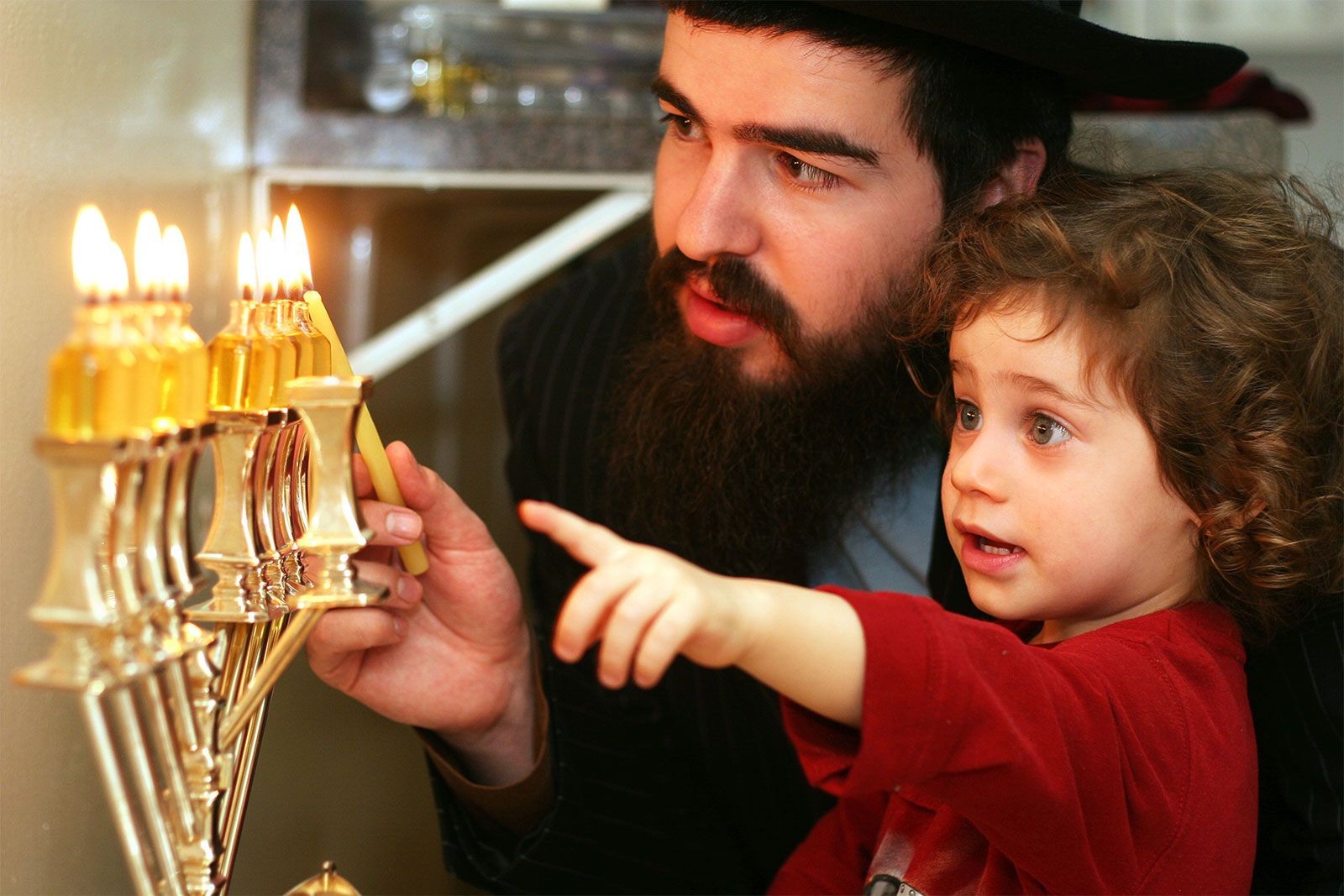Hanukkah, also known as the Festival of Lights, is a cherished eight-day Jewish holiday celebrated annually around the month of December. This joyous festival commemorates a pivotal moment in Jewish history: the rededication of the Second Temple in Jerusalem. At its heart, Hanukkah reaffirms the enduring ideals of Judaism and serves as a powerful symbol of resilience and faith. While not mentioned in the Hebrew Scriptures, Hanukkah has grown to become one of the most beloved and widely observed Jewish holidays around the world.
Historical Roots of Hanukkah
 Lighting the Menorah during Hanukkah, symbolizing the festival of lights and rededication.
Lighting the Menorah during Hanukkah, symbolizing the festival of lights and rededication.
The origins of Hanukkah are rooted in a tumultuous period in Jewish history during the 2nd century BCE. Judaea was under the rule of Antiochus IV Epiphanes, the Seleucid king, who sought to impose Hellenistic culture and suppress Jewish practices. This oppression culminated in the desecration of the Second Temple in Jerusalem, a sacred site of immense importance to the Jewish people. Antiochus outlawed Jewish religious practices and erected an altar to Zeus in the Temple, an act considered a profound sacrilege.
In response to this religious persecution, a rebellion ignited, led by the Maccabees – initially spearheaded by Mattathias and later by his son, Judah Maccabee. Unlike previous Jewish battles fought for survival, the Maccabean revolt was a fight for religious freedom and the right to practice Judaism. After three years of courageous struggle against the Seleucid forces, the Maccabees achieved a remarkable victory.
In 164 BCE, the Maccabees triumphantly reclaimed Jerusalem and set about purifying and rededicating the desecrated Second Temple. This rededication is the central event that Hanukkah commemorates. The festival was established to celebrate this victory and the restoration of Jewish worship at the Temple. The eight-day duration of Hanukkah was proclaimed by Judah Maccabee to mirror the eight-day celebration of Sukkot (Feast of Tabernacles), which the Jews had been unable to observe properly during the oppressive Seleucid rule.
The Miracle of the Oil: Why Eight Nights?
A central legend associated with Hanukkah, detailed in the Talmud, explains the eight-day duration of the festival through the miracle of the oil. When the Maccabees sought to relight the Temple’s menorah (candelabra), they discovered only a single flask of pure olive oil, enough to burn for just one day. Miraculously, this small amount of oil burned for eight full days, providing enough time to produce new consecrated oil for the Temple.
This miraculous event is widely considered the reason Hanukkah is celebrated for eight nights. The lighting of candles each night of Hanukkah on a special candelabrum called a Hanukkiah (or Hanukkah menorah) directly commemorates this miracle. The Hanukkiah holds nine candles: one for each of the eight nights, and a “shamash” (servant) candle used to light the others.
There is a scholarly debate recorded in the Talmud between the schools of Hillel and Shammai regarding the correct way to light the Hanukkah candles. The school of Hillel advocated for progressively increasing the light each night, starting with one candle on the first night and increasing to eight on the final night, symbolizing increasing holiness. This practice of increasing light each night is the custom that is widely followed today.
Celebrating Hanukkah Today: Traditions and Customs
Hanukkah is observed in homes and synagogues around the world with various meaningful traditions and customs. The most central ritual is the nightly lighting of the Hanukkiah. Each night, an additional candle is lit after sundown, accompanied by special blessings, songs, and readings. The Hanukkah lights are traditionally displayed prominently in windows to publicly proclaim the miracle of Hanukkah.
Food plays a significant role in Hanukkah celebrations, particularly foods fried in oil, symbolizing the miracle of the oil. Popular Hanukkah dishes include latkes (potato pancakes) and sufganiyot (jelly-filled doughnuts). These delicious treats serve as a tasty reminder of the historical miracle.
Gift-giving has become a prominent modern custom during Hanukkah, especially in Western cultures. Children often receive gifts of “Hanukkah gelt” (money) or other presents. Another popular tradition is playing dreidel, a four-sided spinning top game. Each side of the dreidel bears a Hebrew letter, representing the phrase “Nes Gadol Haya Sham” – “A great miracle happened there,” referring to the miracle of the oil in Jerusalem.
While historically considered a minor religious holiday, Hanukkah has gained significant popularity in modern times, particularly in countries with large Jewish populations. Its proximity to Christmas has also influenced some modern celebratory customs, particularly in North America, leading to increased emphasis on gift-giving and festive decorations. In Israel, Hanukkah is a national holiday, marked by public menorah lightings, school plays, and special events.
In conclusion, Hanukkah is a vibrant and meaningful Jewish festival that commemorates the rededication of the Second Temple and the Maccabees’ victory for religious freedom. The eight-day celebration, highlighted by the nightly candle lighting and the story of the miracle of the oil, serves as a powerful reminder of faith, resilience, and the triumph of light over darkness. Hanukkah continues to be a cherished holiday, celebrated with joy and tradition by Jewish communities worldwide.
